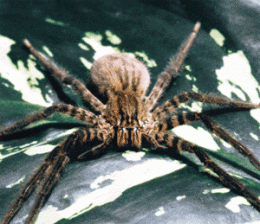October 28, 2011 report
Spider is the second most vibration-sensitive creature

(PhysOrg.com) -- A new study in Austria has confirmed that spiders are extremely sensitive to vibrations, and determined they are the second most vibration-sensitive organism, topped only by cockroaches.
Spiders of all kinds have long been known to be sensitive to vibratory stimulation, since vibrations on their webs or on foliage alert them to the presence of prey. If the vibrations are within a defined frequency and amplitude range, spiders attack the vibration source. Vibrations with characteristics outside these biologically meaningful ranges do not induce an attack response.
The new research, led by Clemens F. Schaber of the University of Vienna’s Department of Neurobiology, used scanning white light interferometry and micro-force measurements for the first time to quantify the forces on spider strain sensors that detect vibrations, to try to determine just how sensitive they were.
The spider they chose was the adult female Cupiennius salei, the Central American wandering spider, which they had bred in their laboratory, and which they chose for its large size and its hunting style of detecting vibrations in the foliage as their prey moves around nearby. The wandering spider derives its name from its habit of wandering about at night on the trees on which it lives, rather than building a web and waiting for prey to become entrapped. Females can reach a leg span of 10 centimeters, with a body length of up to 3.5 centimeters.
Team member Friedrich G. Barth explained that the spider has over 3,000 strain sensors in its body, mostly on the legs and in vibration receptors located near the leg joints. Each strain sensor comprises a series of arrays of tiny parallel slits in the compound lyriform slit sense organs that detect vibrations and movements. When forces are applied the slits are compressed and stimulated.
The researchers found that the sensitivity of the slits decreased with their length and that nanoscale compressions from 1.4 to 30 nanometers caused by vibrations and air flows could be detected. These compressions corresponded to forces as low as 0.01 mN.
Spiders can also see prey even at low light levels, and can detect odors through hair sensors (pedipalps) on their feelers.
The results of the study were published in the Journal of the Royal Society Interface.
More information: Force transformation in spider strain sensors: white light interferometry, J. R. Soc. Interface, Published online before print October 26, 2011, doi: 10.1098/rsif.2011.0565
Abstract
Scanning white light interferometry and micro-force measurements were applied to analyse stimulus transformation in strain sensors in the spider exoskeleton. Two compound or ‘lyriform’ organs consisting of arrays of closely neighbouring, roughly parallel sensory slits of different lengths were examined. Forces applied to the exoskeleton entail strains in the cuticle, which compress and thereby stimulate the individual slits of the lyriform organs. (i) For the proprioreceptive lyriform organ HS-8 close to the distal joint of the tibia, the compression of the slits at the sensory threshold was as small as 1.4 nm and hardly more than 30 nm, depending on the slit in the array. The corresponding stimulus forces were as small as 0.01 mN. The linearity of the loading curve seems reasonable considering the sensor's relatively narrow biological intensity range of operation. The slits' mechanical sensitivity (slit compression/force) ranged from 106 down to 13 nm mN−1, and gradually decreased with decreasing slit length. (ii) Remarkably, in the vibration-sensitive lyriform organ HS-10 on the metatarsus, the loading curve was exponential. The organ is thus adapted to the detection of a wide range of vibration amplitudes, as they are found under natural conditions. The mechanical sensitivities of the two slits examined in this organ in detail differed roughly threefold (522 and 195 nm mN−1) in the biologically most relevant range, again reflecting stimulus range fractionation among the slits composing the array.
© 2011 PhysOrg.com
















